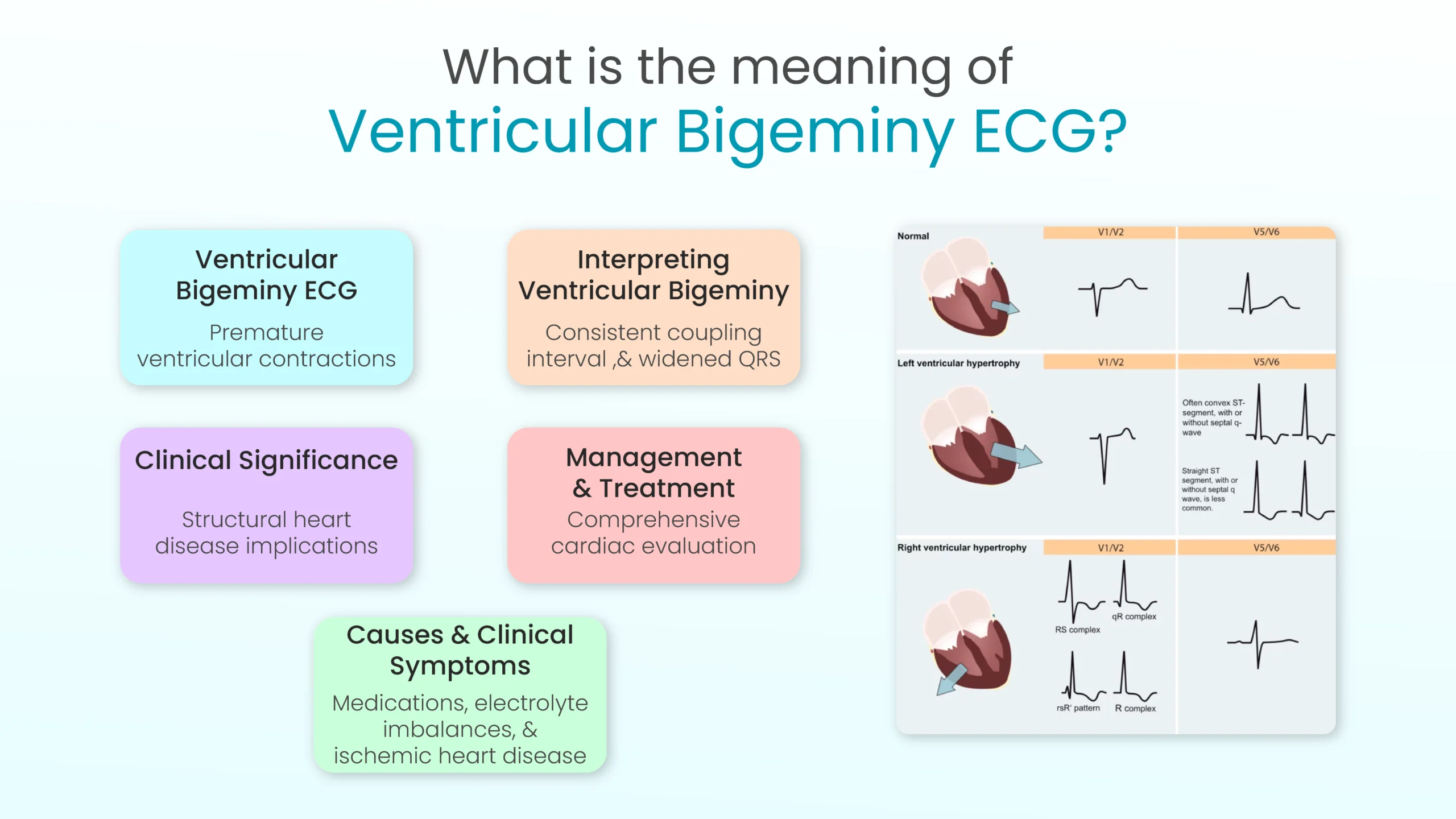
Author:- Mr. Ritesh Sharma
In the domain of cardiac care, an electrocardiogram is one of the most important screening tests. While an ECG can detect a variety of abnormalities- ranging from heart palpitations to cardiac arrhythmias to heart attacks, Ventricular Bigeminy ECG holds a distinct significance in the test. Ventricular Bigeminy ECG is characterized by the QRS complex abnormalities and there are many intricacies in this heart abnormality which is indicated on the electrocardiogram.
In this blog, we will study the meaning, interpretation, and clinical significance of ventricular bigeminy as showcased in the ECG. So, both general people and clinicians who want to learn about ventricular bigeminy ECG will get educated and empowered through this blog.
Understanding ECG
Before delving into the complexities of the ventricular bigeminy ECG, it is important that we understand ECG first. An electrocardiogram or an ECG is a screening test in which through components such as electrodes, leads, amplifiers, and a recording device, the electrical activity of the heart is recorded from various positions. To do so, healthcare professionals place electrodes on various parts of the patient’s body. These parts generate electrical impulses and amplifiers amplify them and show in waveforms on the recording ECG.
These waveforms are P-waves, QRS complexes, and T-waves. In medical terms, they are called, Atrial depolarization, Ventricular depolarization, and Ventricular repolarization respectively. In a normal ECG, all these waveforms are in an ideal state. However, in an abnormal ECG, such as a ventricular bigeminy ECG, there is some disruption in these waveforms.
What is Ventricular Bigeminy ECG?
Ventricular Bigeminy is a condition in which a normal sinus rhythm originated from the natural pacemaker of the heart, i.e. sinoatrial node is followed by a premature ventricular contraction. In simpler words, each normal rhythm of the heart is followed by a premature contraction originating in the lower chambers of the heart, i.e. the ventricles. Due to this, a pattern is shown on the ECG which is unmistakably of ventricular bigeminy ECG. This pattern can be observed by a healthcare professional with razor-sharp observation.
The term bigeminy originally comes from a Latin word. In this, the segregation of the term is done. “Bi” means twice and “geminus” means twin. This emphasized the alternating nature of the beats.
Interpreting Ventricular Bigeminy on ECG
Now comes the important question that clinicians must ponder- how to interpret ventricular bigeminy ECG? On an ECG tracing, ventricular bigeminy is presented as a distinct pattern. Normal sinus beats are followed by PVCs, resulting in a coupling interval, the time between a normal beat and a premature beat, that remains consistent throughout the rhythm strip. Typically, the QRS complex of a PVC appears wider and bizarre compared to a normal QRS complex, reflecting aberrant ventricular depolarization.
Clinical Significance
Ventricular bigeminy ECG holds great significance for clinicians. This is because, can have various implications depending on the underlying cause, the patient’s clinical condition, and associated symptoms. While isolated occurrences of ventricular bigeminy may be benign and asymptomatic, persistent or frequent occurrences can signify underlying cardiac pathology. Here are some potential causes and clinical implications:
- Structural Heart Disease: Underlying structural abnormalities of the heart, such as myocardial infarction, cardiomyopathy, or valvular disease, can predispose individuals to ventricular arrhythmias like bigeminy. These conditions alter the electrical conductivity of the heart, leading to the generation of ectopic beats from the ventricles.
- Electrolyte Imbalance: Disturbances in electrolyte levels, particularly potassium and magnesium, can disrupt the normal electrical activity of the heart, increasing the propensity for arrhythmias including ventricular bigeminy. Monitoring and correcting electrolyte imbalances are crucial in managing such cases.
- Medications and Stimulants: Certain medications, such as antiarrhythmics, psychotropic drugs, and stimulants like caffeine, can trigger ventricular arrhythmias. Patients with a history of arrhythmias should be cautious about the use of such medications and substances.
- Ischemic Heart Disease: Inadequate blood supply to the heart muscle, as seen in ischemic heart disease, can predispose individuals to ventricular arrhythmias. This may result from coronary artery disease, myocardial infarction, or other ischemic conditions affecting the heart.
- Clinical Symptoms: While some individuals with ventricular bigeminy may remain asymptomatic, others may experience palpitations, chest discomfort, dizziness, or syncope (fainting). These symptoms warrant further evaluation to assess the severity of the arrhythmia and its impact on cardiac function.
Management and Treatment
For the management and treatment of ventricular bigeminy as showcased in the ECG; you have to adopt a steadfast approach. This approach involves identifying the underlying causes and opting for correct treatment strategies. Furthermore, you must also opt for relevant management plans involving lifestyle modifications and more. Let’s learn more about the management and treatment of ventricular bigeminy ECG below:
- Comprehensive Cardiac Evaluation: This includes a thorough medical history, physical examination, ECG monitoring, echocardiography, and laboratory investigations to identify the underlying etiology.
- Lifestyle Modifications: Adopting a heart-healthy lifestyle, including regular exercise, a balanced diet, smoking cessation, and moderation in alcohol and caffeine intake, can help reduce the risk of arrhythmias.
- Medications: Depending on the underlying cause and clinical presentation, medications such as beta-blockers, calcium channel blockers, or antiarrhythmic drugs may be prescribed to stabilize the heart rhythm.
- Interventional Procedures: In some cases, individuals with refractory ventricular arrhythmias may require invasive interventions such as catheter ablation or implantation of an implantable cardioverter-defibrillator (ICD) to manage the arrhythmia and prevent sudden cardiac death.
In conclusion, ventricular bigeminy ECG gives vivid insights into the underlying causes of the condition. Unlike ventricular trigeminy, ventricular bigeminy is less hazardous and poses less risk to cardiovascular health. However, some underlying conditions associated with it warrant immediate medical intervention. So, you must be cautious if you are detected by it.



